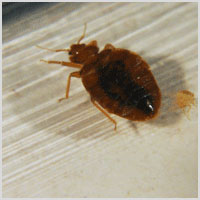Bed Bugs
 Common Name: Bed bugs
Common Name: Bed bugs
Scientific Name:Cimex lectularius
Introduction: This particular insect has received the name bed bugs because of its close association with human bedding. Bedbugs are found worldwide and throughout Britain. Bed bugs spend most of their time hiding in cracks, crevices, furniture, or bedding and will emerge when hungry in search of a blood meal. They can ingest seven times their body weight in blood at any one meal. Bed bugs are ectoparasite of primarily humans but also other domestic animals including cats, dogs, and rodents. Highly sensitive individuals will feel the unpleasant irritation following their bites. Although bed bugs have been suspected to transmit diseases, in most cases conclusive evidence is lacking.
Recognition: Bed bugs are broadly oval and flat. The adults are reddish brown in colour depending on how recently they have been fed. The nymphs are off-white or light cream; this colour will suddenly change once they start feeding. When present in sufficient numbers, it is possible to detect an obnoxiously odour which is emitted from their glands.
Biology: Egg> Nymph> Adult. Mating takes place off the host. The female bed bugs lay four to five eggs per day with an average total of 200 eggs. The eggs are deposited in cracks, crevices, bed frames, mattress seams, beneath torn wall paper, picture/mirror frames, skirting boards, furniture, ceiling covings, window curtains, rough surfaces and secured with transparent cement for an average total of 200 eggs. There are five growth stages; each growth stage may take a few weeks to several months depending on food supply and conditions. They require about three to ten minutes for each blood meal, during which saliva containing an anti-coagulant is injected into the blood stream to prevent blood clotting. The eggs will not hatch under 10-13oC. The developmental time from egg to adult takes about 21 days at 20-30°C to 120 days at 15-18°C. Nymph development and adult activity is 12-15°C. Below 16°C adults enter semi-hibernation and the heat stress death point is 43 to 45°C. With a blood meal the nymphs can survive an average of 51 days (range 28 to 73) and an adult can live up to 9 to 18 months pending on food supply (blood or host) and conditions. Bedbugs are able to survive 6 to 12 months without a host.
Potential harm: Many diseases have been related to bedbugs due to feeding on different human or hosts. Such diseases are malaria, yellow fever, west nile virus, and even Hepatitis B. Scientifically this has not been proven, and in most cases bought forward conclusive evidence is lacking. One assured evidence is highly sensitive humans will feel the unpleasant irritation from the bite of a bedbug.
Habitat: Bed bugs come out to feed at night and sometimes during the day. They can be found around mattress seams and buttons, wooden and metal bed frames, picture and mirror frames, night stands, furniture, skirting boards, beneath floor-boards, cracks, crevices behind loose wallpaper, light switches, door and window frames, sofas, window curtains etc. In heavy infestations, bed bugs may be found in wall voids, attics, and other enclosed places. They are introduced into buildings or homes through used furniture and by someone who has reside previously in bedbug infested area (human traffic). Bed bugs have also been found in transportation vehicles.
Control Measures: Affected areas should be treated at once with approved pesticide. If some are present in the affected area, persons should be moved to another location without any luggage. Subject to severe infestations they should be provided with alternate lodging or sleeping accommodations until the problem is resolved. If pesticide exposure becomes a health concern, infested bed frames, mattresses or upholstered furniture can be discarded and replaced with new once the area has been treated professionally. Newly replacement mattresses should be with special zippered encasements to prevent re-infestation by bed bugs. Filter bags should be discarded after vacuuming to prevent escape and re-infestation by surviving bed bugs. Bed coverings, clothing and comfort toys suspected of being infested with bed bugs should be dry cleaned or washed and tumble dried at temperature above 45°C. Contact us today to solve your pest control in London.




























